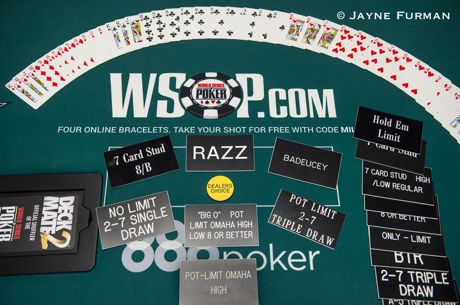Five Tips That Will Help You Crush Mixed Games

Many poker players have grown tired of No Limit Hold'em-tired of the excessive tanking, the crowd of aggressive geniuses, and the solver-based strategies that have in a strange way spoiled the game.
The same cannot be said for mixed games, where the action is fast and the players are, for the most part, inexperienced. Mixed games are thus an attractive option if you're looking for opportunities to make a profit playing poker.
Today we have 5 tips for mixed games to share with you, which cover each of these game types:
- Razz
- Seven-Card Stud
- Stud 8-or-Better
- Omaha 8-or-Better
- 2-7 Triple Draw
These tips come straight from Upswing Poker's advanced mixed games course, which was created by high stakes mixed games specialist Jake "Jllama" Abdalla. Jake is undoubtedly an expert in these game types, he has winnings of $1.3 million on PokerStars alone:

Let's talk strategy!
1. Razz: Defend Your 'Bring-In' Liberally
A lowball variant of Seven Card Stud, Razz is a game where the best A-5 low hand wins at showdown.
Many new players feel lost when it comes to hand selection in Razz, particularly when it comes to defending the 'bring-in.' In his course, Jake outlines crucial points to follow when you're in this position.
The first is that you should defend your bring-in fairly liberally, similar to how you would defend the big blind in No Limit Hold'em. This is because of the exceptional pot odds you are getting on a call, which is a result of the game's antes. Even xxT and xxJ type hands will have reasonable equity versus opponents with a low door card:
- 6x9x 10x vs XxXx 8x has 50% equity
- 2x5x 10x vs XxXx 8x has 57% equity
- 2x5x Jx vs XxXx 4x has 49% equity
However, you should fold hands with a Qx or Kx door card versus a raise from a player with XxXx8x, despite the odds. This is because such hands tend to under-realize their equity, as opponents can and should play aggressively against them.
The Razz section of Jake's mixed games course covers everything you need to excel in this variant. It includes street-by-street strategy and eye-opening hand reviews, with analysis of cash games, WCOOP and SCOOP events.
2. Seven-Card Stud: Don't Underestimate the Importance of Card Removal
At one time the most popular poker game before the No Limit Hold'em boom, Stud is a game where the strongest five-card hand at showdown wins.
As with all Stud variants, removal plays a significant role in hand strength. At an 8-handed table, there will be seven door cards exposed in addition to your own at the beginning of each hand (called 'third street'). With so much information about removal available, it is important to pay close attention to the dead cards and factor them into your decision-making.
Let's look at an example calculation that illustrates how removal affects hand equity:
| Hands: 8♠6♠ 4♠ VS J♥J♦ 2♣ | Equity Split: | 40% | / | 60% |
| With 3 spades dead: | Equity Split: | 35% | / | 65% |
| 9♠ 7♠ 5♠ dead: | Equity Split: | 33% | / | 67% |
| J♣ dead: | Equity Split: | 43.5% | / | 56.5% |
| J♣ 2♦ dead: | Equity Split: | 46% | / | 54% |
| J♣ J♠ 2♦ 2♥ dead: | Equity Split: | 50% | / | 50% |
The changes in dead cards caused the equities to shift by as much as 17 percentage points! A shift this large can make a hand go from playable to unplayable.
Granted, differences in equity will usually be smaller, but small edges add up over time. Calculating how removal changes the strength of your hand is a skill worth honing if you want to crush Stud.
3. Stud 8-or-Better: the Best Starting Hands Can Win the High and the Low
Stud 8-or-Better is a dynamic game where the pot is split evenly between the best low hand, which must be eight-low at worst, and the best high hand. Straights and flushes don't count against the low hand.
Since players are competing for both the best low and high hands, starting hand selection is one of the most important and interesting facets of Stud 8. The split pot component of the game allows for many more playable hands than in other Stud variants.
Aces are very powerful in Stud 8 since they can be both high and low.
Aces are very powerful in Stud 8 since they can be both high and low. Here's how you should approach starting hand selection by position when you have an ace in your hand:
- Late position: Open-raise any time you have an ace exposed unless another ace is exposed behind, in which case you should fold some of the worst aces.
- Middle position: Open-raise combos that contain an ace and at least one low card (eight or lower).
- Early position: You should aim to have three low cards, a pair, or three-to-a-flush when open-raising.
Note that middling cards (8x-Jx) are particularly weak in Stud 8 since they are least likely to help you win either the low or high portions of the pot.
In contrast to other game types, stealing in Stud 8 is ineffective. This is as a result of the bring-in being determined by the lowest card exposed, and low cards are advantageous in this split-pot format.
4. Omaha 8-or-Better: Play Hands With Multiple Components
Also known as "Omaha Hi/Lo," or "O8," this is a split-pot game with the same high and low rankings as Stud 8. However, Omaha rules apply insofar as a hand must always be comprised of two cards from your hand and three from the board.
Similar to Stud 8, we want to play O8 hands that can compete for both the low and high parts of the pot. These hands will have to be suited and connected-components that allow them to make the nuts easily.
Not only will multi-component hands do better at showdown, but they also realize their equity better post-flop due to their drawing potential.
Not only will multi-component hands do better at showdown, but they also realize their equity better post-flop due to their drawing potential. In multi-way pots, being able to make the nuts is particularly valuable given how easy it is to make strong hands in Omaha. This means that suited Ax-combos, especially Ax2x, are ideal.
In O8, you must be careful to avoid playing hands that look better than they actually are. Below are a couple of examples of hands that would be considered playable in regular Omaha, but are terrible in the Hi/Lo variant:
- Middling rundowns, such as Jx10x9x8x or QxJx10x9x: unplayable in most situations, except from the blinds. These hands cannot compete for the low portion of the pot, and they make many second-best high hands.
- Middling, double-paired hands, such as 10x10x5x5x: combos like these are too one-sided, and they perform poorly for the high hand. They will often make bottom/middle set with little or no re-draw equity.
5. 2-7 Triple Draw: Stand Pat as a Bluff When You Have Great Blockers
2-7 Triple Draw is draw variant where the best low hand wins. It also has a different ranking system than the other lowball games discussed here. Aces are always high, and straights and flushes count. This makes 7x5x4x3x2x the best possible hand.
One of the most enjoyable strategies of Triple Draw is "snowing," which is when you stand pat (draw no cards) as a bluff to represent a strong made hand and subsequently bet the river.
Effective snowing harnesses the power of blockers.
Effective snowing harnesses the power of blockers. A deuce is the strongest blocker due to its low value and limited ability to draw.
A prime example of snowing with good blockers would be with a hand like 2x2x3x3x7x. This hand heavily blocks our opponent from having or drawing to nutted hands, which makes it more likely that they will fold by showdown.
Snowing without effective blockers can be reasonable in some situations; in particular, when your opponent is drawing to multiple cards (a move which weakens their range). It is important to draw no more than one card in these scenarios because representing a strong range yourself increases the likelihood that the snow gets through.
The Lowdown
Mixed games present a lucrative opportunity. But also consider that learning new variants of poker can rejuvenate your love for the game.
Jake's course is a comprehensive resource that will help you crush these games, and his expert coaching doesn't end when the 102 videos do. All members also get access to the private Mixed Games Facebook group, which is frequented by Jake. The group is a great place to pose strategy questions and connect with coaches and other members of the Upswing community.
Learn more about the mixed games course here!
Sponsor generated content by Upswing Poker








